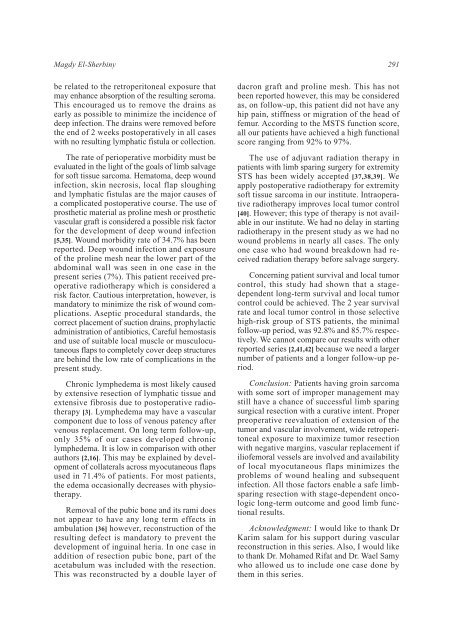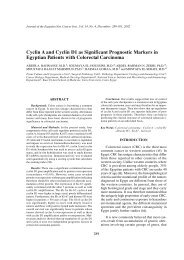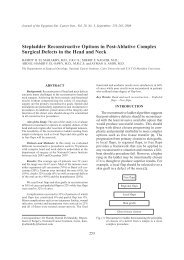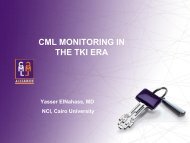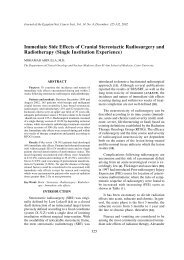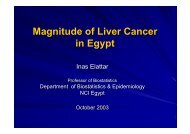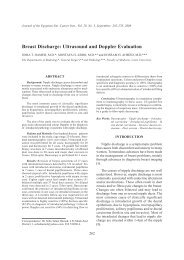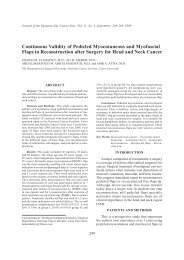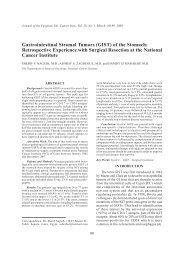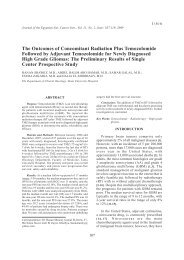Limb Sparing Surgical Resection of Groin Sarcoma. Surgical ... - NCI
Limb Sparing Surgical Resection of Groin Sarcoma. Surgical ... - NCI
Limb Sparing Surgical Resection of Groin Sarcoma. Surgical ... - NCI
You also want an ePaper? Increase the reach of your titles
YUMPU automatically turns print PDFs into web optimized ePapers that Google loves.
Magdy El-Sherbiny 291be related to the retroperitoneal exposure thatmay enhance absorption <strong>of</strong> the resulting seroma.This encouraged us to remove the drains asearly as possible to minimize the incidence <strong>of</strong>deep infection. The drains were removed beforethe end <strong>of</strong> 2 weeks postoperatively in all caseswith no resulting lymphatic fistula or collection.The rate <strong>of</strong> perioperative morbidity must beevaluated in the light <strong>of</strong> the goals <strong>of</strong> limb salvagefor s<strong>of</strong>t tissue sarcoma. Hematoma, deep woundinfection, skin necrosis, local flap sloughingand lymphatic fistulas are the major causes <strong>of</strong>a complicated postoperative course. The use <strong>of</strong>prosthetic material as proline mesh or prostheticvascular graft is considered a possible risk factorfor the development <strong>of</strong> deep wound infection[5,35]. Wound morbidity rate <strong>of</strong> 34.7% has beenreported. Deep wound infection and exposure<strong>of</strong> the proline mesh near the lower part <strong>of</strong> theabdominal wall was seen in one case in thepresent series (7%). This patient received preoperativeradiotherapy which is considered arisk factor. Cautious interpretation, however, ismandatory to minimize the risk <strong>of</strong> wound complications.Aseptic procedural standards, thecorrect placement <strong>of</strong> suction drains, prophylacticadministration <strong>of</strong> antibiotics, Careful hemostasisand use <strong>of</strong> suitable local muscle or musculocutaneousflaps to completely cover deep structuresare behind the low rate <strong>of</strong> complications in thepresent study.Chronic lymphedema is most likely causedby extensive resection <strong>of</strong> lymphatic tissue andextensive fibrosis due to postoperative radiotherapy[3]. Lymphedema may have a vascularcomponent due to loss <strong>of</strong> venous patency aftervenous replacement. On long term follow-up,only 35% <strong>of</strong> our cases developed chroniclymphedema. It is low in comparison with otherauthors [2,16]. This may be explained by development<strong>of</strong> collaterals across myocutaneous flapsused in 71.4% <strong>of</strong> patients. For most patients,the edema occasionally decreases with physiotherapy.Removal <strong>of</strong> the pubic bone and its rami doesnot appear to have any long term effects inambulation [36] however, reconstruction <strong>of</strong> theresulting defect is mandatory to prevent thedevelopment <strong>of</strong> inguinal heria. In one case inaddition <strong>of</strong> resection pubic bone, part <strong>of</strong> theacetabulum was included with the resection.This was reconstructed by a double layer <strong>of</strong>dacron graft and proline mesh. This has notbeen reported however, this may be consideredas, on follow-up, this patient did not have anyhip pain, stiffness or migration <strong>of</strong> the head <strong>of</strong>femur. According to the MSTS function score,all our patients have achieved a high functionalscore ranging from 92% to 97%.The use <strong>of</strong> adjuvant radiation therapy inpatients with limb sparing surgery for extremitySTS has been widely accepted [37,38,39]. Weapply postoperative radiotherapy for extremitys<strong>of</strong>t tissue sarcoma in our institute. Intraoperativeradiotherapy improves local tumor control[40]. However; this type <strong>of</strong> therapy is not availablein our institute. We had no delay in startingradiotherapy in the present study as we had nowound problems in nearly all cases. The onlyone case who had wound breakdown had receivedradiation therapy before salvage surgery.Concerning patient survival and local tumorcontrol, this study had shown that a stagedependentlong-term survival and local tumorcontrol could be achieved. The 2 year survivalrate and local tumor control in those selectivehigh-risk group <strong>of</strong> STS patients, the minimalfollow-up period, was 92.8% and 85.7% respectively.We cannot compare our results with otherreported series [2,41,42] because we need a largernumber <strong>of</strong> patients and a longer follow-up period.Conclusion: Patients having groin sarcomawith some sort <strong>of</strong> improper management maystill have a chance <strong>of</strong> successful limb sparingsurgical resection with a curative intent. Properpreoperative reevaluation <strong>of</strong> extension <strong>of</strong> thetumor and vascular involvement, wide retroperitonealexposure to maximize tumor resectionwith negative margins, vascular replacement ifili<strong>of</strong>emoral vessels are involved and availability<strong>of</strong> local myocutaneous flaps minimizes theproblems <strong>of</strong> wound healing and subsequentinfection. All those factors enable a safe limbsparingresection with stage-dependent oncologiclong-term outcome and good limb functionalresults.Acknowledgment: I would like to thank DrKarim salam for his support during vascularreconstruction in this series. Also, I would liketo thank Dr. Mohamed Rifat and Dr. Wael Samywho allowed us to include one case done bythem in this series.


